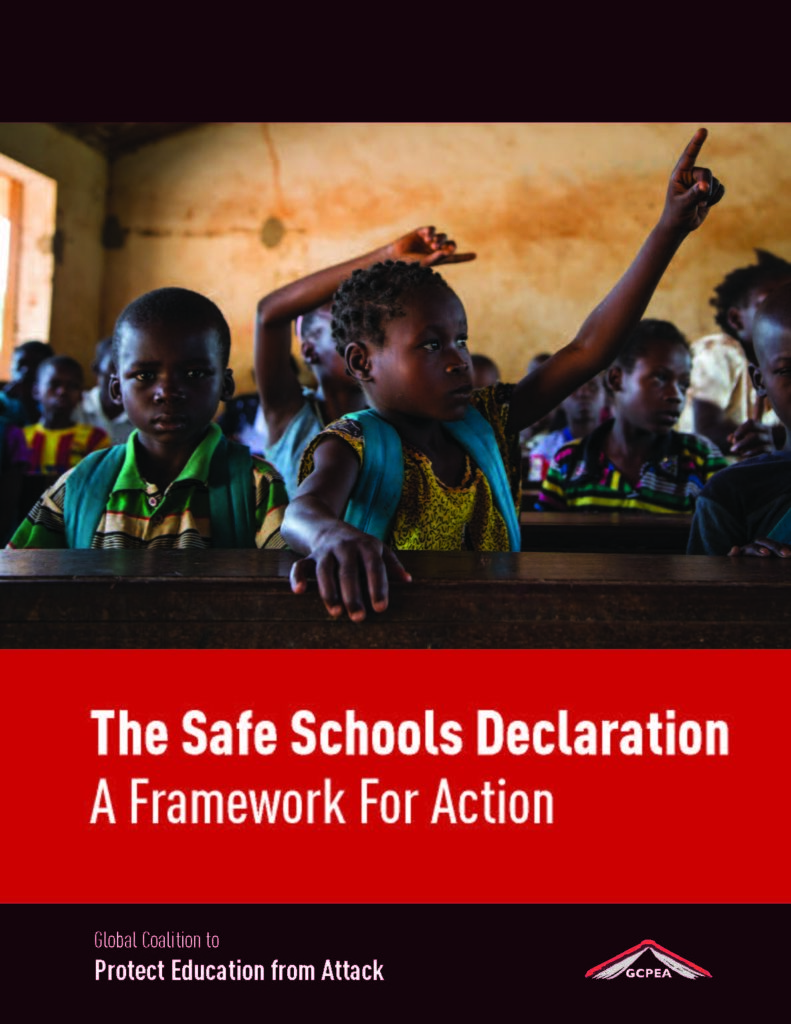GCPEA News
GCPEA releases Framework for Action to implement the Safe Schools Declaration
GCPEA PRESS RELEASE, November 30, 2017
(Geneva, November 30, 2017) – At a high-level event today in the United Nations in Geneva, hosted by Ambassador Héctor Marcelo Cima of Argentina and Ambassador Hans Brattskar of Norway, the Global Coalition to Protect Education from Attack (GCPEA) released a new tool to support governments in making schools and universities safer in the midst of insecurity and war.
The Safe Schools Declaration: A Framework for Action provides governments with suggestions, recommendations, and examples of good practice to assist them in implementing the Safe Schools Declaration, a political commitment developed by the governments of Norway and Argentina, and aimed at enhancing protection for schools and universities, students, and educators during war-time.
“The Framework for Action highlights measures that countries have already taken to implement each commitment within the Safe Schools Declaration,” said Diya Nijhowne, GCPEA director. “By drawing inspiration from the experiences of their peers, governments can craft strategies for protecting education that best fit their unique circumstances.”
Also at today’s event, Argentina’s ministry of foreign affairs launched the outcome report of the Buenos Aires Conference on Safe Schools, which took place from March 28-29, 2017. During the international conference, which was attended by representatives of more than 90 states, the international community discussed the serious challenges that students and teachers face in situations of conflict, and shared experience of using the Safe Schools Declaration as an operational framework to improve their protection.
Seventy-one countries have endorsed the Safe Schools Declaration to date, and many of them have taken significant steps to implement commitments within the Declaration. Denmark recently changed its military manual to emphasize the importance of avoiding military use of schools, while New Zealand has amended its Law of Armed Conflict Manual to include explicit protection of education institutions. Slovenia and Switzerland are in the process of making similar revisions.
Conflict-affected countries, such as Nigeria and Palestine, have enhanced security in schools, while Somalia has developed alternative means of education in insecurity by providing instruction via radio. Other examples included in the Framework outline steps that governments can take to improve the collection of data on attacks, provide assistance to victims, and seek accountability for attacks.
“Attacks on schools, students, and teachers are a regular feature of armed conflict and can have devastating impacts, including death, injury, and extended school closures, and this often leads to teachers fleeing and students dropping out,” said Nijhowne. “Attacks can also deprive children of the protective benefits of school, leaving them more vulnerable to sexual and other forms of exploitation, recruitment as child laborers or soldiers, or, for girls, early marriage and pregnancy.”
Attacks on schools and universities often occur when armed forces or armed groups are using the premises for military purposes. Using a school as a barracks, base, weapons cache, firing position, armory, or detention center can potentially turn the building into a military target. Military use of educational infrastructure can endanger students’ and teachers’ safety and hinder access to education. The Safe Schools Declaration includes a commitment to endorse and use the Guidelines for Protecting Schools from Military Use during Armed Conflict to better protect against these risks. The Guidelines were developed in a process spearheaded by GPCEA and finalized by states in December 2014.
Since 2013, according to GCPEA’s research, armed forces and armed groups have used schools and universities for military purposes in at least 28 countries in armed conflict and insecurity around the world. Research by the GCPEA has also shown that, within the same timeframe, a series of attacks on schools has occurred in 28 countries experiencing armed conflict and insecurity.
“Implementation of the Safe Schools Declaration, and the accompanying Guidelines on avoiding military use of schools, can help to mitigate the risks of attacks on education,” said Nijhowne. “GCPEA’s Framework for Action should serve as a guide for governments as they take steps to better protect schools, universities, students, and teachers from the effects of war.”
The Framework for Action is currently available in Arabic, English, French, and Spanish, and will shortly be available in Portuguese.





